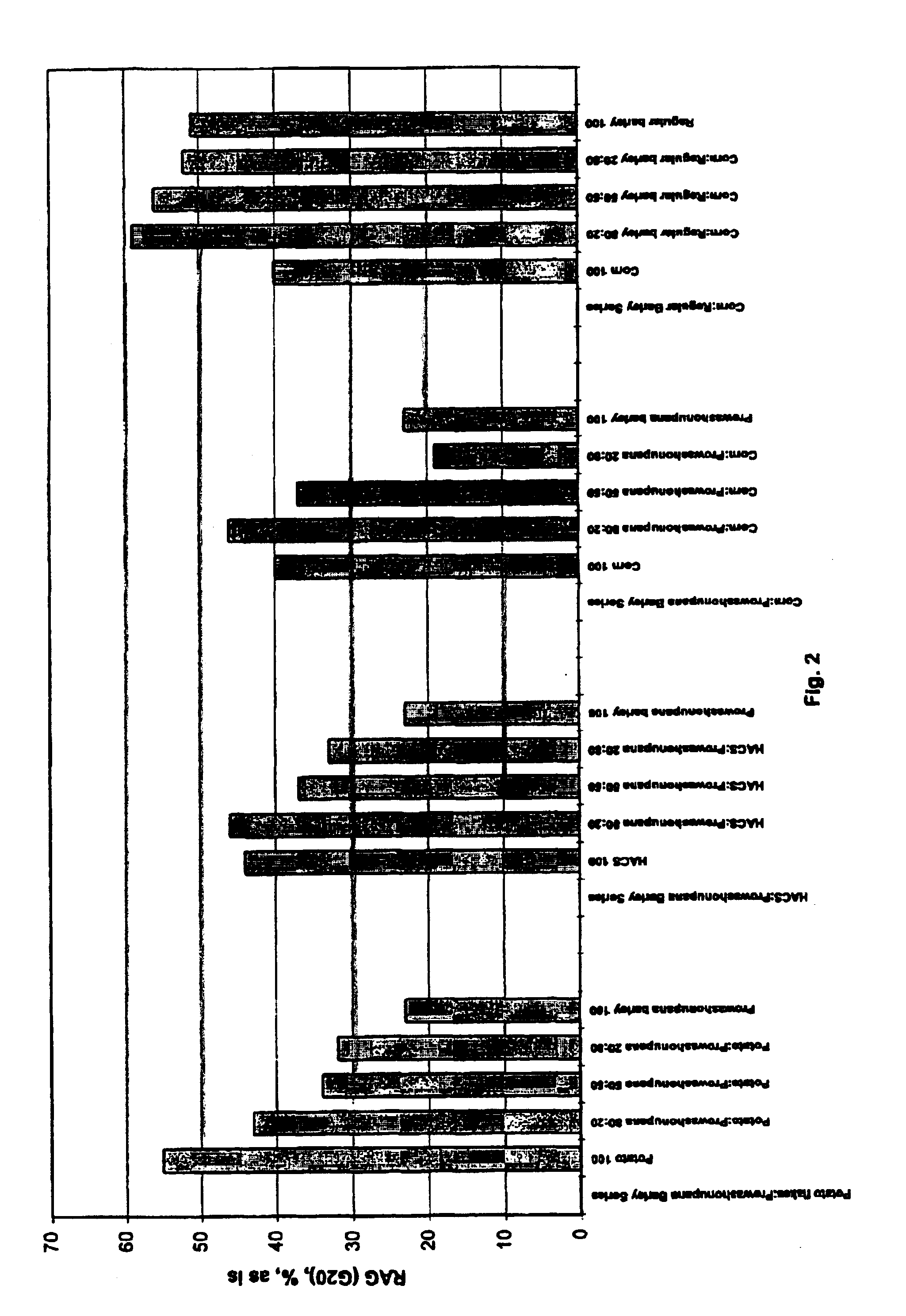Method and composition related to low glycemic index foods
a low glycemic index, food technology, applied in food preparation, sweetmeat, bakery products, etc., can solve the problems of reducing the insulin response, reducing the gi level of subjects, and high incidence of obesity, so as to promote good health and lower the rag in subjects. , the effect of promoting good health
- Summary
- Abstract
- Description
- Claims
- Application Information
AI Technical Summary
Benefits of technology
Problems solved by technology
Method used
Image
Examples
example 1
An extruded flaked-type cereal was produced by combining Prowashonupana barley flour with either high amylose corn starch or soy flour. Additionally, added to the barley mixture were flavor ingredients. The constituents were mixed in a standard mixer to form a homogenous mix composition. The homogenous mixture was then fed into a pre-conditioner, which was a Wenger TX-57 rotating at a speed of 350 rpm. The steam flow into the pre-conditioner was equal to between 8 kg and 9 kg per hour, and the water flow was equal to between 15 kg and 16 kg per hour.
After conditioning, the material was then fed into a Wenger TX 57 twin screw extruder cooker. The moisture content of the mixture entering the extruder was between 23% and 29%, and the extruder had a shaft speed equal to 350 rpm. The steam flow into the extruder was equal to between 5 kg and 6 kg per hour, and the water flow was equal to between 3 kg and 20 kg per hour. The flavor constituents were added to the extruder at a rate equal t...
example 2
An extruded flaked-type cereal was again produced by the same procedure as recited in Example 1. Four runs of different constituents were conducted. The constituents for each run are listed below in Table 6.
[t8]
The flavor constituents added are listed in Table 7.
[t9]
The individual constituents and combination of constituents were analyzed prior to extrusion. The results are disclosed in Table 8.
[t10]
After extrusion, the products were analyzed, with the results listed below:
[t11]
The products with the highest percentage of Prowashonupana barley had the highest percentage of protein, fiber, and O-glucan. They also had the lowest RAG. This demonstrates that use of the Prowashonupana produces a superior product that lowers RAG, while still imparting desirable nutritional components.
example 3
A direct expanded snack product was produced by combining Prowashonupana barley flour with either potato flakes, high amylose corn starch (HACS), or corn snack meal in varying percentages by weight. One percent salt was also added to each formula. The constituents were mixed in a standard mixer to form a homogenous mix composition. The homogenous mixture was then fed into a pre-conditioner, which was a Wenger TX-57, rotating at a speed of 125 rpm. There was no steam or water fed to the pre-conditioner. The material exited from the pre-conditioner at 25.degree. C.-29.degree. C.
The material was then fed into a Wenger TX-57 twin screw extruder cooker. The extruder shaft speed ranged from 350 rpm-450 rpm. The water flow into the extruder ranged from 20-50 kg / hr. The temperature in the first head of the extruder was equal to between 50.degree. C.-80.degree. C., and the temperature in the second head of the extruder was equal to between 100.degree. C.-110.degree. C. The knife drive speed ...
PUM
 Login to View More
Login to View More Abstract
Description
Claims
Application Information
 Login to View More
Login to View More - R&D
- Intellectual Property
- Life Sciences
- Materials
- Tech Scout
- Unparalleled Data Quality
- Higher Quality Content
- 60% Fewer Hallucinations
Browse by: Latest US Patents, China's latest patents, Technical Efficacy Thesaurus, Application Domain, Technology Topic, Popular Technical Reports.
© 2025 PatSnap. All rights reserved.Legal|Privacy policy|Modern Slavery Act Transparency Statement|Sitemap|About US| Contact US: help@patsnap.com


